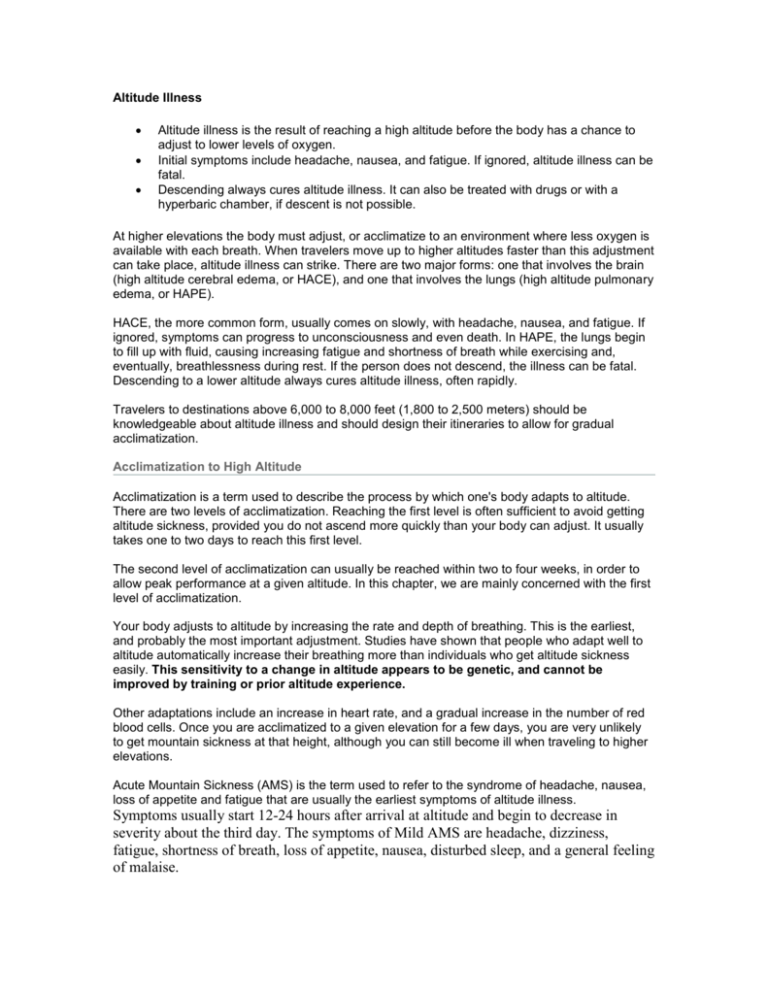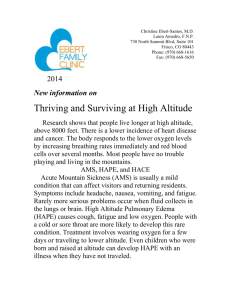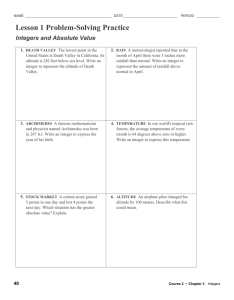Altitude Sickness
advertisement

Altitude Illness Altitude illness is the result of reaching a high altitude before the body has a chance to adjust to lower levels of oxygen. Initial symptoms include headache, nausea, and fatigue. If ignored, altitude illness can be fatal. Descending always cures altitude illness. It can also be treated with drugs or with a hyperbaric chamber, if descent is not possible. At higher elevations the body must adjust, or acclimatize to an environment where less oxygen is available with each breath. When travelers move up to higher altitudes faster than this adjustment can take place, altitude illness can strike. There are two major forms: one that involves the brain (high altitude cerebral edema, or HACE), and one that involves the lungs (high altitude pulmonary edema, or HAPE). HACE, the more common form, usually comes on slowly, with headache, nausea, and fatigue. If ignored, symptoms can progress to unconsciousness and even death. In HAPE, the lungs begin to fill up with fluid, causing increasing fatigue and shortness of breath while exercising and, eventually, breathlessness during rest. If the person does not descend, the illness can be fatal. Descending to a lower altitude always cures altitude illness, often rapidly. Travelers to destinations above 6,000 to 8,000 feet (1,800 to 2,500 meters) should be knowledgeable about altitude illness and should design their itineraries to allow for gradual acclimatization. Acclimatization to High Altitude Acclimatization is a term used to describe the process by which one's body adapts to altitude. There are two levels of acclimatization. Reaching the first level is often sufficient to avoid getting altitude sickness, provided you do not ascend more quickly than your body can adjust. It usually takes one to two days to reach this first level. The second level of acclimatization can usually be reached within two to four weeks, in order to allow peak performance at a given altitude. In this chapter, we are mainly concerned with the first level of acclimatization. Your body adjusts to altitude by increasing the rate and depth of breathing. This is the earliest, and probably the most important adjustment. Studies have shown that people who adapt well to altitude automatically increase their breathing more than individuals who get altitude sickness easily. This sensitivity to a change in altitude appears to be genetic, and cannot be improved by training or prior altitude experience. Other adaptations include an increase in heart rate, and a gradual increase in the number of red blood cells. Once you are acclimatized to a given elevation for a few days, you are very unlikely to get mountain sickness at that height, although you can still become ill when traveling to higher elevations. Acute Mountain Sickness (AMS) is the term used to refer to the syndrome of headache, nausea, loss of appetite and fatigue that are usually the earliest symptoms of altitude illness. Symptoms usually start 12-24 hours after arrival at altitude and begin to decrease in severity about the third day. The symptoms of Mild AMS are headache, dizziness, fatigue, shortness of breath, loss of appetite, nausea, disturbed sleep, and a general feeling of malaise. Moderate AMS includes severe headache that is not relieved by medication, nausea and vomiting, increasing weakness and fatigue, shortness of breath, and decreased coordination (ataxia). Normal activity is difficult, although the person may still be able to walk on their own. At this stage, only advanced medications or descent can reverse the problem. Severe AMS presents as an increase in the severity of the aforementioned symptoms, including shortness of breath at rest, inability to walk, decreasing mental status, and fluid buildup in the lungs. Severe AMS requires immediate descent to lower altitudes (2,000 - 4,000 feet [610-1,220 meters]). AMS has been reported at altitudes as low as just over 6,000 feet (1,800 meters), although it occurs more commonly and more severely at higher altitudes. Not only mountain climbers and high altitude trekkers are at risk of developing altitude illness; there are also many cases of altitude illness every year among skiers in Colorado and other high-elevation ski areas, with occasional deaths. High Altitude Cerebral Edema (HACE) is the term that is used to refer to severe acute mountain sickness in which a person begins to lose coordination, becomes confused and gradually lapses into coma. HACE is nearly always fatal if the person is not transported to a lower altitude immediately. HACE is caused by fluid collecting in the brain; symptoms include headache, loss of appetite, nausea, and sometimes vomiting. The individual becomes increasingly tired and lethargic. As the condition progresses, difficulties with balance and coordination (ataxia) develop. High Altitude Pulmonary Edema (HAPE) refers to fluid leaking into the lung tissue-causing cough, shortness of breath on exertion, and increasingly severe shortness of breath even at rest. The cough, initially dry and irritating, can progress to the production of pink, frothy sputum in the most severe form of the illness. The person ultimately drowns in this fluid if she or he doesn't descend in time. HAPE can be rapidly fatal if it is not possible to get the person to a lower altitude. It can occur either along with AMS or HACE, or by itself. HAPE and HACE can occur singly or in combination AMS only rarely suddenly strikes an unsuspecting trekker; it is almost always preceded by the early warning signs of headache or shortness of breath.








